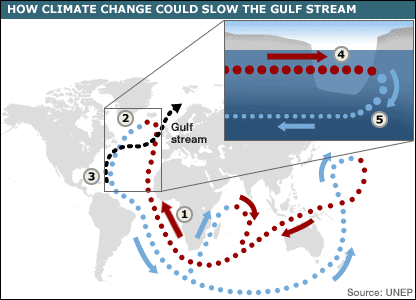 |
 |
 |
 Editorials | Environmental | February 2005 Editorials | Environmental | February 2005  
Guide to Climate Change - The Gulf Stream
 BBC BBC



1 Surface currents carry warm, salty water from the tropics.
2 The water cools, its density increases and it sinks to the deep ocean.
3 The cold water flows back to the equator, driving the "ocean conveyor" which in turn contributes to the Gulf Stream that warms northern Europe.
4 As ice melts, freshwater dilutes the warm salty water from the tropics.
5 The water becomes less dense so does not sink as fast, weakening the "conveyor" and therefore the Gulf Stream. |
Gulf Stream

Dramatic temperature shifts have happened in the past, driven partly by changes in a major ocean currents.

A "great ocean conveyor" helps transport heat around the globe via surface and deep-sea movements of water.

Scientists are exploring whether global warming might slow or shut it down - a scenario considered "low probability, high impact".

This could disrupt mostly wind-driven surface currents such as the Gulf Stream, which brings milder weather to Northern Europe. | 
 | |
 |



